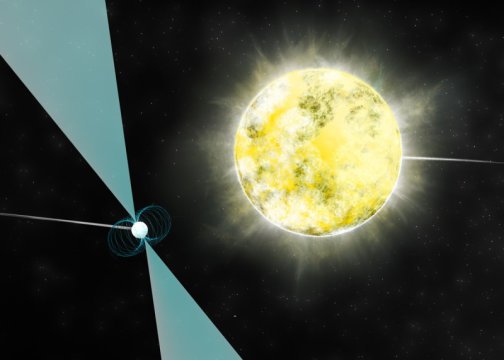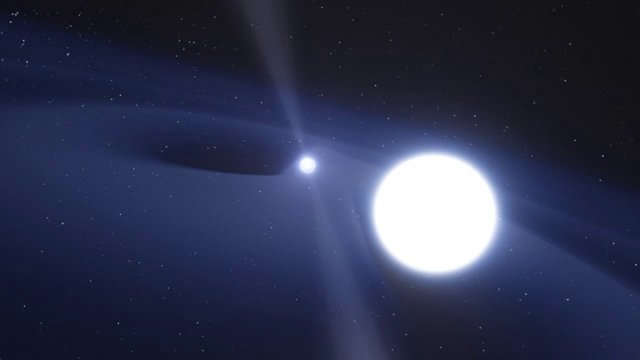Earth-sized Diamond Star in Space

Ever heard of Diamond song from Rihanna? I've heard but because not a fan I do not know exactly the contents of the song. But if I'm not mistaken, there's a pretty poetic part of saying We're like diamonds in the sky. The point is still glowing like a diamond in the sky.
And it turns out ... the diamond in the sky did exist. It is are the remains of Earth-sized ancient stars!, in the form of white dwarfs and planets. This means diamonds in space is not something rare.
This time, another diamond was discovered by astronomers! The object of this carbon crystallization is the coldest and darkest white dwarf star ever detected. The white dwarf is the Earth-sized ancestral star! There is a diameter the size of Earth in the sky! Fortunately, humans can not get there. If not, of course, has become a new mining location.
How can this white dwarf diamond be found? Moreover, the white dwarf found is very dim. It must be hard to find it.
Discovery of PSR J2222-0137
The story begins with the discovery of a pulsar or a star of a pulsating star which is a very fast spinning neutron. The neutron star is the remnant of a massive mass of stars that explode as a supernova. This star is very compressed and when it spins, radio waves like the lights of the lighthouse flows from the magnetic poles into the sky waiting to be captured by the radio telescope on Earth as it approaches the blue planet.The pulsar, codenamed PSR J2222-0137, was discovered by Jason Boyles of West Virginia University in Morgantown while observing with Green Bank's National Radio Astronomy Observatory (NRAO) Telescope. From Jason Boyles's observations, the pulsar appears to rotate 30 times per second and has a gravitational attachment to its partner's object. At first, the paired stars of the pulsar are thought to be neutron stars or unusually cold, white rare stars. Both of them orbit every 2.45 days.
Further observations of the PSR pulsar J2222-0137 were conducted with Very Long Baseline Array (VLBA) by Adam Deller of the Netherlands Institute for Radio Astronomy (ASTRON) for two years. From this observation, astronomers can know the distance and location of the pulsar. PSR J2222-0137 is known to be in the constellation Aquarius at a distance of 900 light years from Earth.
Dwarf Star White Diamond
By using Einstein's theory, astronomers can know the role of gravity of a pair's star objects in warping time so that there is a delay in radio signals when the pulsar is behind it. This time delay is what helps astronomers to know the orbital orientation and mass of the two paired stars. Pulsar PSR J2222-0137 has a mass of 1.2 mass of the Sun while its star mass is 1.05 solar masses.From the existing data, a paired star in the system may not be a neutron star because its regular orbit signifies no second supernova that occurs in the system. This means that the object of the pulsar pair is a white dwarf that should be observed in optical and infrared wavelengths. And just as expected, the Southern Astrophysical Research (SOAR) telescope in Chile and the 10-meter Keck telescope in Hawaii managed to detect the presence of the white dwarf.
The white dwarf pair of PSR J2222-0137 that should appear in the observed image with a brightness 100 times dimmer than the other white dwarf star around the neutron star is not visible. That is, if the white dwarf is there then of course it is a very cool star. The temperature is estimated at about 3000 Kelvin or 2700 Celsius. Even the Sun at its center is 5000 times hotter. Interestingly, the white dwarf found around the neutron star is about the same age as the Milky Way about 11 billion years old. It's very old is not it?
The white dwarf is the final evolution of a star whose mass is smaller than the six Sun masses, after which the star has partially massed it. At this stage, there is no central reaction going on in the center. Most of the hydrogen in the center has run out and its chemical composition is almost completely composed of heavier elements, such as carbon and oxygen. Since there is no more core power source, the white dwarf will continue to cool for billions of years into a dark dwarf.
The white dwarf PSS J2222-0137 pulsar star is a carbon star that is crystallized and similar to the diamond we know on Earth. To be sure, diamond stars or carbon stars are crystallized, not a rare star. However, its very dimness makes it difficult for astronomers to detect its existence. Astronomers are fortunate enough to find this white dwarf star because it is in a double star so it can be detected by its presence.
Reference :
- http://www.iflscience.com/space/earth-sized-diamond-discovered-space/
- http://earthsky.org/space/earth-sized-diamond-in-space-is-coolest-white-dwarf-star
- http://www.astronomy.com/news/2014/06/remarkable-white-dwarf-star-possibly-coldest-dimmest-ever-detected


